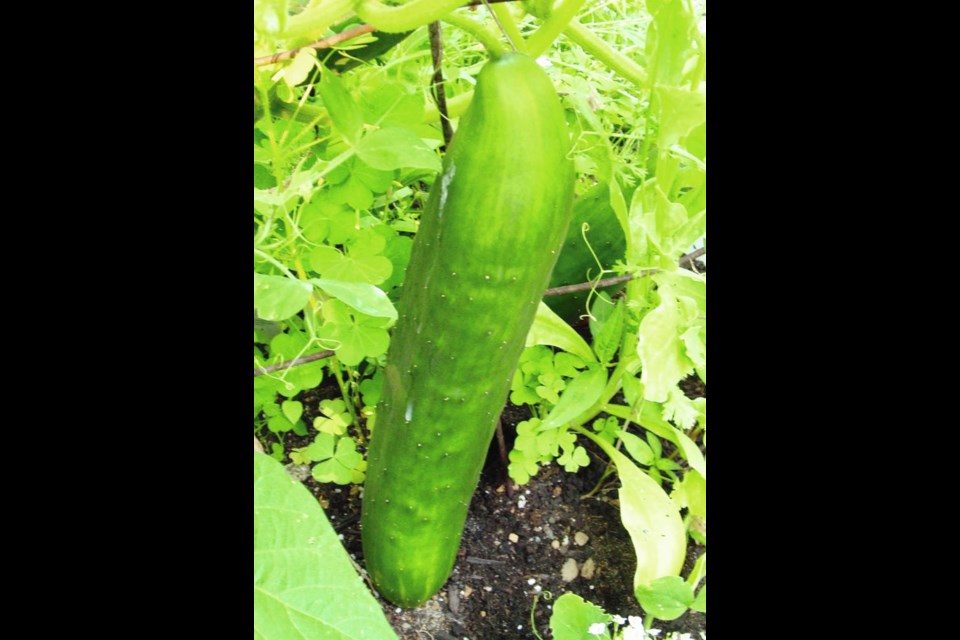Dear Helen: In a long, deep, narrow box planter in my greenhouse there is a series of tall, large-leaved cucumber vines that began flagging last month. The leaves are slightly yellowed and limp. The nicely formed, long cucumbers on the vines have also begun to yellow at one end. The leaves recover only a little in cooler overnight temperatures. A ground-level melon plant in the same bed still has rich green leaves.
W.T.
It is probable that the unusually high heat levels this summer have adversely affected the large cucumber plants. If this summer is delivering a hint of what the future holds, I’d consider growing melons in the greenhouse planter and the cucumbers outdoors.
Melons will tolerate extreme heat more easily an cucumbers — especially cucumber varieties with long vines, big leaves and long fruits.
Big, vigorous cucumber plants would also probably do better and last longer in good productive condition with a more extensive root run.
Here’s what I would do. First, harvest at least the largest cucumbers to lessen stress on the plants.
If the soil surface is perfectly flattened, stir it up lightly between the plants with a hand cultivator to help facilitate water penetration.
Check moisture levels in the soil and if needed, give the bed a long, slow watering, ending with a dilute fish fertilizer solution. Follow that with a generous mulching with a nourishing compost. I use fish compost because it’s easily available where I live and it has so far worked effectively to perk up plants in my garden.
I routinely use this compost to mulch long-term plantings like tomato, cucumber and squash vines. I do this when they begin flowering, after weeding and cultivating lightly around the plants and watering well. Subsequent waterings leach the nutrients in the compost down to the plant roots.
Dear Helen: For the past several years I’ve grown fernleaf dill, a dwarf variety called Ella, from West Coast Seeds. The seeds are no longer available from this source. This dwarf variety is perfect for containers and for growing in small patches in my raised vegetable beds where space is limited. Where can I find a similar type of dill? I use small amounts of it for cooking almost every day, even through much of the winter when I grow it indoors.
K.S.
I see on the West Coast Seeds website that they hope to offer Ella again next year. The plants are described as growing to just 35 cm tall. Meanwhile, William Dam Seeds (Ontario) lists a Fernleaf dill that grows to 45 cm.
Johnny’s Selected Seeds in Maine lists a Fernleaf dill described as growing just 15 to 20 cm tall — “great for containers or in small spaces.” I order from both catalogues every year, and value them as interesting, reliable seed sources.
Dear Helen: This year’s snap pea plants were more loaded with pods than any we’ve grown before, but the pods are tough and chewy, even the smallest ones. What a disappointment. What could have caused this?
D.H.
Toughness in snap peas is most commonly caused by letting them grow too large or not eating them soon enough after picking. Snap pea pods are usually at their best at 10 cm or less in length. Soon after picking, the pods loose sweetness and become starchy.
Heat, soil moisture and the variety can also affect pod quality. Peas do not react well to high heat levels, especially sudden heat. Adequate, consistent soil moisture is needed to produce tender, sweet, crisp pods. Try more than one variety to see which produces best in your conditions. Sugar Ann is an extra-early, award winning variety with six-cm pods.
After growing snap peas for years I switched to snow peas. Oregon Giant is a wonderful variety.
Dear Helen: A question in a recent column asked about getting rid of liverwort in garden beds. I heard that baking soda will do the job. Is this true?
W.P.
One of the owners of Russell Nursery tells me that baking soda sprinkled on liverwort quickly turns the growth black and kills it.
A word of caution: Their use of baking soda has been solely on gravel-covered pathways around the nursery, not on soil. In fact, a buildup of baking soda (sodium bicarbonate, a salt) in soil can cause stunting in plants.



